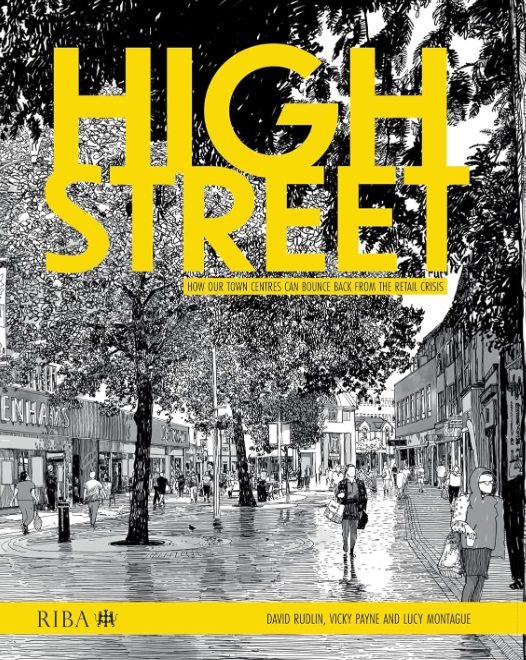High Street: how our centres can bounce back from the retail crisis
High Street: how our centres can bounce back from the retail crisis, David Rudlin, Vicky Payne and Lucy Montague, RIBA Publishing, 2023, 230 pages, 94 illustrations, paperback.
High Street is a timely survey of the economic, social and cultural trends shaping high streets in towns like yours and mine. The joint authors, with backgrounds in urbanism and urban design, work in academia and consultancy, while Rudlin and Payne co-authored the National Model Design Guide. The book is beautifully illustrated with the authors’ own line drawings.
The authors provide a sector-by-sector analysis of the fortunes of the high street, beginning by taking a long view of its prospects. The present crisis is just one stage in a continuous process of change. The traditional high street was once challenged by supermarkets. Later the threat came from out-of-town retail. More recently the high street has been under pressures from the financial crisis, deals like the private equity takeover of Debenhams, and by online retailing and the pandemic. The authors hope ‘that (the book) goes a little way to bringing together the worlds of retail and the built environment to develop a shared agenda for the development of high streets’. They believe there are cautious grounds for optimism.
Part three of the book is the most forward-looking and the part in which conservation professionals might see a role. In one of a series of examples, the authors describe Will Alsop’s vision of Barnsley as a Tuscan hill town. Although the vision was not implemented, it changed the perception of the local council and local people of what Barnsley was and might become. In nearby Doncaster, local creatives developed the Doncopolitan: a blog, radio show and magazine aiming to develop a new vision for the town based on creative arts. Much has been achieved on the ground, but retail strategy is still seen as largely separate from this source of energy and innovation.
From the 1990s, Frome in Somerset has developed a community-based strategy to bring small-scale and start-up retail into vacant units in the town centre, and to introduce a huge, monthly Sunday market. This has involved reinventing the role of the town council in which all members now serve as independents.
Many high streets are in the inner suburbs of cities. Examples such as Leicester’s Belgrave Road and the Balti Triangle in Ladypool, Birmingham, demonstrate how diverse communities can turn high streets into something exciting and different.
Elsewhere, all is not well in the inner suburban high street. The authors trace the loss of high streets in Greater Manchester and other cities. These places were once distinct from town centres but provided strips of ‘super diversity that ran for miles through cities’. Even here, though, examples from London, Newcastle and Sheffield show that high streets can prosper by providing local retailing within an economy increasingly based on cafes, restaurants and bars.
The book concludes on an optimistic note. The authors make a distinction between a retail crisis and a crisis for the high street. The collapse of property investment that lies behind the decline of the town centres can provide an escape from potentially damaging schemes planned in the 2000s. The hope for the future lies with independent businesses and the relocation of retailers such as Ikea in the high street. Other promising trends include a convergence of online and physical retailing, and an enduring demand for authenticity and uniqueness. Perhaps most important is a desire for experience: eating, drinking and meeting friends, rather than accumulating more stuff.
The strategies for reviving the high street mean more planning, not less. We can hope that they also bring, as Jane Jacobs wrote more than 50 years ago, a recognition of the importance of historic buildings.
This article originally appeared as ‘Accumulation and experience’ in the Institute of Historic Building Conservation’s (IHBC’s) Context 178, published in December 2023. It was written by Michael Taylor, editorial co-ordinator for Context.
--Institute of Historic Building Conservation
Related articles on Designing Buildings
- Becoming Jane Jacobs.
- Commons Committee report on High Street support addresses evidence submitted by IHBC.
- Conservation.
- Funding for heritage on the high street.
- Heritage.
- High street.
- High streets heritage action zones.
- Historic environment.
- IHBC articles.
- Institute of Historic Building Conservation.
- Jane Jacobs and garden villages.
- Sensory and emotional histories of the high street.
IHBC NewsBlog
IHBC Context 183 Wellbeing and Heritage published
The issue explores issues at the intersection of heritage and wellbeing.
SAVE celebrates 50 years of campaigning 1975-2025
SAVE Britain’s Heritage has announced events across the country to celebrate bringing new life to remarkable buildings.
IHBC Annual School 2025 - Shrewsbury 12-14 June
Themed Heritage in Context – Value: Plan: Change, join in-person or online.
200th Anniversary Celebration of the Modern Railway Planned
The Stockton & Darlington Railway opened on September 27, 1825.
Competence Framework Launched for Sustainability in the Built Environment
The Construction Industry Council (CIC) and the Edge have jointly published the framework.
Historic England Launches Wellbeing Strategy for Heritage
Whether through visiting, volunteering, learning or creative practice, engaging with heritage can strengthen confidence, resilience, hope and social connections.
National Trust for Canada’s Review of 2024
Great Saves & Worst Losses Highlighted
IHBC's SelfStarter Website Undergoes Refresh
New updates and resources for emerging conservation professionals.
‘Behind the Scenes’ podcast on St. Pauls Cathedral Published
Experience the inside track on one of the world’s best known places of worship and visitor attractions.
National Audit Office (NAO) says Government building maintenance backlog is at least £49 billion
The public spending watchdog will need to consider the best way to manage its assets to bring property condition to a satisfactory level.

















